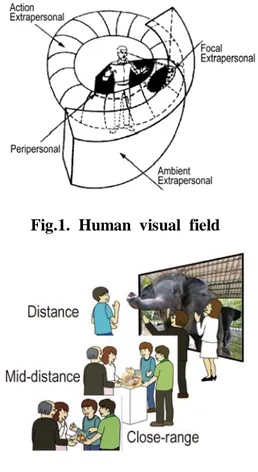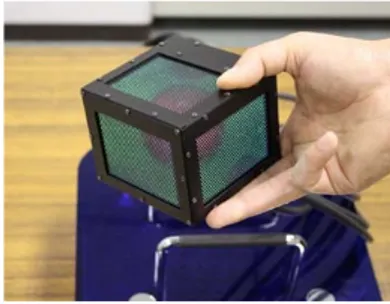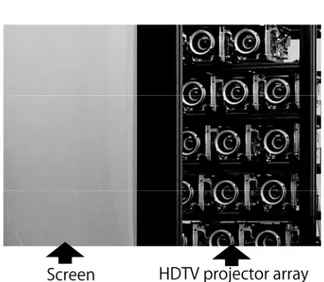60-3 / S. Yano
IMID 2009 DIGEST •
Abstract
We have developed several three-dimensional display systems matched to human visual field characteristics. In this article, we describe these systems corresponding to a close-range, mid-distance and distance view, and also the image pickup equipments related to these display systems.
1. Introduction
The National Institute of Information and Communication Technology (NICT) began research project on “Research on Ultra-Realistic Communications” from April 2006. In this research, the means of communication for tactual and olfactory senses in addition to three-dimensional image and sound systems, the evaluation method for the sensation of reality and human perception, and the cognitive mechanism for such information are investigated for realizing the ultra-realistic communication system.
This research project has been carried out by the “3D spatial image and sound group” and the “Multimodal communication group” at NICT Universal Media Research Center. For developing the three-dimensional image technology, the 3D spatial image and sound group developed the electric holography system and the multimodal communication group developed the light field reproduction three-dimensional image system. In this article, the current status of the research of light field reproduction three-dimensional image system is described.
2. Relationship between stereoscopic
display and human visual field
2.1 Development of stereoscopic display based on human visual fieldFig. 1 shows one of the human visual field models (1). This model shows that the human visual field not only has a characteristic in the horizontal and vertical direction but also has one in the depth direction. We assume that human communications are performed under the conditions of a close-range, mid-distance, and distance view, as shown in
Fig. 2, on the basis of the assumption of the characteristics shown in Fig. 1. We started to develop three kinds of stereoscopic displays. The first one is the auto-stereoscopic cubic-type display, which displays the three-dimensional image on hand and is operated as the interface device. The second is also the auto-stereoscopic display, which displays the reproduction image on the tabletop for the surrounding viewers. The third is the large-screen auto-stereoscopic display, which displays a person, a relatively big object, or the background scene, without glasses. A close-range, mid-distance, and distance view corresponded to the focal extrapersonal, peripersonal, and action extrapersonal, respectively; further, they also corresponded to the cubic, tabletop, and large-screen auto-stereoscopic displays, respectively.
Fig.1. Human visual field
Considerations about the Development of Three-dimensional
Display Systems Adopted for Human Visual Field
Sumio YANO
NICT Universal Media Research Center
2-2-2 Hikaridai, Keihanna Science City, Kyoto 619-0288 JAPAN Phone: +81-774-95-2659, E-mail: yano.s@nict.go.jp
60-3 / S. Yano
• IMID 2009 DIGEST
Fig. 2. Human visual communication
2.2 Basic performance of auto-stereoscopic display From the viewpoint of general display systems, stereosco pic displays are divided into three groups as shown below
(2)
.
(1) Stereoscopic image display
(2) Multi-view reproduction image display (3) Light field reproduction image display
For (1), the display equipment is not suitable for the communication tool because of the un-changing scene at the time of the movement of the gaze point with the head motion. In other words, this display does not generate suitable images for the changing of viewpoints. For (2), this display system has to be examined more, and it has already been developed as general auto-stereoscopic display systems. For (3), this equipment also has to be examined and it has been developed actively in these days.
For (2), the major problems are generally reproducing smooth motion parallax and avoiding the conflict between convergence and accommodation response. In this display system, the vertical disparity is not considered. The viewpoints for smooth motion parallax and the avoiding method, which is called the super-multi-view, of the conflict between convergence and accommodation response were studied for this type of display. For (3), the smooth motion parallax is observed inevitably, and the possibility of the conflict between convergence and accommodation response is considered as a low probability in this display type. The setting-up of the vertical is possible, although the resolution remained at a low level when the vertical disparity is introduced using the present panel for two-dimensional images.
In our research project, we examined the requirements for each display based on the characteristics of the human visual field. As for the cubic-type display on hand, we adopted (3)-type display, namely introducing the vertical disparity, because of operating it on hand. For the tabletop-type display, we also adopted (3), although we do not set-in the vertical disparity on it. This is because we think that the display is used by sitting viewers. Further, this type display can be adopted by (2). In the case of a large screen display, we adopted (2) and (3) for obtaining a high picture quality without using vertical disparity.
3. Development of auto-stereoscopic displays
3.1 Auto-stereoscopic cubic-type display(3)This display consists of six LCD-panels in all faces including top and bottom faces, and three-dimensional images are displayed in this cubic-type display. This display is made of flat display panels, namely LCD panels, and a fly-eye lens. The display method is based on integral-photography (IP). The most significance difference from
conventional IP is the application of ultra-wide angle lens array (120°). For this reason, viewers can observe three-dimensional images from all directions even when they move the display in any direction. Fig. 3 shows the display devices. A size of the developed cubic-type display is approximately 10 cm for using a 3.5-inch LCD panel. A viewer can take and move this display with one hand because of its small size. However, the resolution of this display is not good enough because of a relatively small size LCD-panel, which is only 480 × 640 dots, and so it has an unsatisfactory picture quality. However, we can use more high-resolution LCD panels in the future, and we will be able to achieve high picture quality for this kind of display.
Fig. 3. Auto-stereoscopic cubic-type display
3.2 Tabletop-type auto-stereoscopic display(4)
Currently, the required development of this display is not sufficient. In this article, the principle of the display method and the differences of conventional IP are briefly described. In this display, the viewers, who sit or stand around the display, observe the images on the tabletop from diagonally above. For this viewing condition, the suitable viewing area is set on the ring appearing above the table, and the light field is in only this area for the optimization of light field reproduction images. It is clear that the representation of binocular disparity in the vertical direction is advisable for this display. However, vertical disparity is not considered when the position of the viewer is almost constant in height and distance from the table.
As shown in Fig. 4, the origin 0 is set at the center of the table; the Z-axis is defined in the upper vertical direction when the X-axis and Y-axis, which are mutually orthogonal, are defined on the table. When a viewer observes the images in the position of distance d and height h from the table, the group area of viewpoint E = (ed*cosθ, ed*sinθ, eh) is defined as the viewing zone. θ indicates the arbitrary viewing angle, which is around the Z-axis, from X-axis. Additionally, the reproduced light field is examined on the plane, for instance, the X-Z plane, which is orthogonal to the X-Y plane. One of the viewing zones is found to be the point of both upper directions from the table, as shown in Fig. 5, and the light field satisfies this condition for displaying an image. For this reason, the requirement of light field for displaying images on the X-Y plane is
60-3 / S. Yano
IMID 2009 DIGEST • defined as the light line group, which are gathered on the
arbitrary viewpoint E of the ring, as shown in Fig. 5, from the position of table. As for the conventional principle of IP, some tens of degrees of viewing zone, in the direction of the Z-axis, covered over the X-Y plane. However, for this display, a wider viewing zone is required for reducing the light line for the inner part of ring and also for spreading the light line for enlarging the ring.
Fig. 4. Principle of light field
Fig. 5. Principle of viewing zone
3.3 Large screen stereoscopic display without glasses(5) The large screen stereoscopic display without glasses has been developed using a 70-inch screen. In this display, the HDTV projector array system was also developed for the purpose of obtaining high picture quality. The major specification is shown in Table 1. The optical engine in the projector has a capability of obtaining HDTV image quality, and embedded OS is installed in each projector. The embedded OS controls the parameter of the projector and processes the image signal. Fig. 6 shows the configuration of this display system, which mainly consists of a screen and a projector array. The light line from each projector is spread in the vertical direction, and not horizontally; therefore, the horizontal disparity is utilized, and not the vertical one. This display system is used as a focal system and an afocal system at the point of the optical display system. In the case of the focal display system for stereoscopic images, the images on the screen have no distortion due to the lens shift function in each projector. As a result, high picture quality stereoscopic images are displayed in this display system. As for the large screen stereoscopic display without glasses, the development
objective at the point of the screen size is using a 200-inch diagonal screen, and we assume that this system can be utilized for the design of an automobile and machine system or the digital signage system as an advertise equipment.
Table 1 Display specifications
Fig. 6. Large screen auto-stereoscopic display
4. Pickup equipment
for auto-stereoscopic displays
4.1 Stitching algorithm for small object(6)Stereoscopic reproductive images of picking up the real object are generated by the camera images, which are taken by a camera surrounded by real objects, or by using distance data, which is measured by using infra-red or laser light. There are many proposal methods for such processing. In our system, the real object on the turntable is rotated; the image and depth information are obtained from several directions. At first, all the images are displayed on the stereoscopic display, as shown in Fig. 7. Next, a rough figure is displayed, and the detailed part is gradually displayed in the display process. Basically, the requirement of less registration error is necessary for this system; the development has been carried out on the basis of this requirement.
60-3 / S. Yano
• IMID 2009 DIGEST
Fig. 7. Display procedure of stitching for the object
4.2 Using depth detection camera for stereo matching(7) Stereo matching is a well-known problem to estimate the depth information from the correlation of right and left images in stereoscopic images. However, there are some problems that increase the calculation time, matching point error, etc. due to the inefficiency of the setting of the search area. For avoiding these inefficiencies and errors, the equipment is developed. The equipment is a combination of the stereo camera and the depth detection camera. In this equipment, the depth detection camera reduces the background and foreground for the search area before stereo matching; the function of stereo matching is performed for the essential area and the depth information is detected. As a result, the depth map using this equipment was generated.
5. Summary
In this article, we described three kinds of auto-stereoscopic display systems and related two pickup equipments, which have been developed at the Universal Media Research Center in National Institute of Information and Communication Technology (NICT). The basic directions of the development for these display systems are based on the characteristics of human visual fields. Further, we also examined the basic requirement for each display from the viewpoint of the viewer’s behavior or performance, and the progress development based on these results. We hope these displays and pickup equipments will contribute in some small way for the design of the future image system.
Acknowledgement
The author would like to thank the many colleagues within NICT who have studied with these research works. Particularly Dr. Lopez-Gulliver, Dr. Iwasawa, Mr. Moldovan, Dr. Yoshida and Dr. Gurbuz. We would also like to thank the people at JVC KENWOOD Holdings, INC. for the cooperation work.
6. References
1. Fred H. Previc, Psychological Bulletin, 124[2], p.123 (1998)
2. Tibor Balogh, SPIE-IS&T, 6055, 60550U-1(2006) 3. R. Lopez-Gulliver, S. Yoshida, S. Yano, N. Inoue, IEEE
Sympo. on 3D User Interfaces, p.157 (2008)
4. S.Yoshida, S.Yano, H. Ando, Proc. of 14thVRSJ (in press)
5. S. Iwasawa, URCF Stereoscopic Display Seminar, Lecture 6 (2009.2)
6. D. Moldovan, S. Yano, N. Inoue, Proc. of The 15th IDW, 3Dp-13L, p.1163 (2008)
7. S. Gurbuz, N. Inoue, Proc. of The 14th IDW, 3D 1-3, p.1169 (2007)


